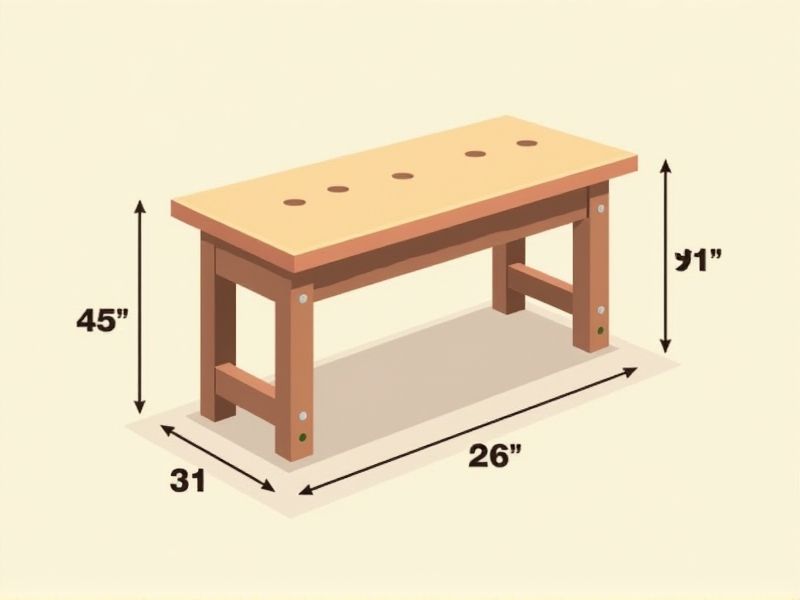
When selecting or building a workbench, understanding standard dimensions ensures comfort and productivity. Most workbenches are about 34 to 36 inches (86 to 91 cm) in height, which suits most standing users and common tasks. Typically, the depth ranges from 24 to 36 inches (61 to 91 cm), providing enough workspace without making tools inaccessible. Lengths often vary from 48 to 96 inches (122 to 244 cm), allowing you to choose a size that fits your workshop and project needs.
Height
A standard workbench height typically ranges from 28 to 34 inches, catering to various tasks and user preferences. For woodworking or metalworking, a height of 30 to 36 inches is often ideal to ensure comfort and efficiency while standing. You may also consider adjustable workbenches, which can vary from 28 to 42 inches, providing flexibility for different projects. Ensuring the workbench is at the right height can significantly enhance productivity and reduce strain during extended use.
Width
A standard workbench typically has a width ranging from 24 to 36 inches, providing ample space for various tasks. The optimal width allows for comfortable movement and access to tools, enhancing productivity during DIY projects or professional work. For specialized tasks, such as woodworking, widths may extend up to 48 inches to accommodate larger materials. Choosing the right workbench width based on your specific needs can significantly improve your workflow and workspace efficiency.
Depth
A high-quality workbench should prioritize a depth measurement that typically ranges from 24 to 30 inches, accommodating various tasks with ease. This depth allows for an optimal workspace where you can comfortably maneuver tools and materials effectively while maintaining organization. An ample depth can also enhance safety, as it provides enough distance from items that could cause injury. Ensure your workbench is constructed from durable materials like hardwood or heavy-duty steel to withstand the wear and tear associated with projects requiring depth in work activities.
Material
The standard of a workbench primarily hinges on the material used, which significantly impacts durability and functionality. High-quality materials like hardwood or steel provide robust support, often rated for a load capacity of up to 1,000 pounds. For specialized applications, consider materials such as laminate or composite, which offer resistance to chemicals and wear, enhancing longevity. Selecting the right material for your workbench will optimize your workspace efficiency and ensure reliable performance over time.
Load Capacity
The load capacity of a workbench is a critical factor, often ranging from 250 to 2,000 pounds, depending on the intended use and construction materials. Typically, heavier-duty workbenches feature robust steel frames and reinforced tabletops to ensure durability and stability. For optimal safety and performance, it's essential to match the load capacity with the specific tasks you'll be performing, such as woodworking or metalworking. When selecting a workbench, consider not only the weight it can support but also its stability under dynamic loads to prevent accidents during use.
Adjustable Legs
Workbench adjustable legs provide enhanced stability and versatility, allowing users to customize working heights from 28 to 42 inches, accommodating various tasks and user preferences. These legs often feature heavy-duty materials, with a weight capacity ranging from 300 to 1,000 pounds, ensuring durability and support for your projects. Many designs incorporate quick-release mechanisms, simplifying adjustments and increasing efficiency during work sessions. This adaptability is particularly beneficial in shared workspaces, where different users can quickly modify the bench to suit their ergonomic needs.
Surface Finish
A high-quality workbench prioritizes surface finish, ensuring a smooth and even texture that enhances precision in various tasks. Ideal surface finishes range from 32 to 64 microinches, impacting both the aesthetic appeal and functional performance of the workspace. Maintaining this standard prevents wear on tools and materials, resulting in increased efficiency during projects. Investing in a workbench with optimal surface finish characteristics can significantly elevate your overall craftsmanship and satisfaction with your work.
Edge Treatment
The standard of a workbench emphasizes precision in edge treatment, which is crucial for ensuring safety and enhancing durability. Typically, a workbench features a smooth, rounded edge with a radius of 1/8 inch to prevent injuries during use. Employing materials like hardwood or high-density laminate not only contributes to aesthetic appeal but also improves resistance to wear and tear. For optimal results, maintaining consistent edge treatment standards can significantly increase the longevity of your workbench while providing a professional finish.
Storage Options
Workbench storage options are essential for maximizing workspace efficiency and organization. Common features include adjustable shelves, tool drawers, and pegboards, allowing for easy accessibility to tools and materials. Many workbenches support a weight capacity ranging from 300 to 1,500 pounds, ensuring durability for various tasks. When choosing a workbench, consider the dimensions of your workspace and the specific storage needs for your tools and equipment.
Ergonomics
An ergonomically designed workbench enhances comfort and productivity, allowing for an optimal working posture. The ideal height for most users ranges from 28 to 34 inches, accommodating a variety of tasks while minimizing strain on the back and shoulders. Incorporating adjustable features, such as height regulation or tilting surfaces, can benefit users by promoting better circulation and reducing fatigue during extended use. Investing in ergonomically sound equipment can lead to a significant decrease in workplace injuries, enhancing overall efficiency by up to 25%.
